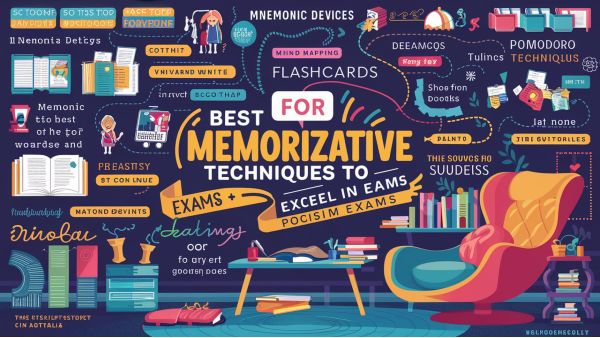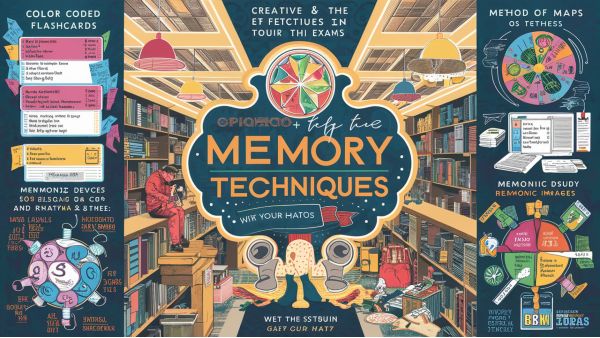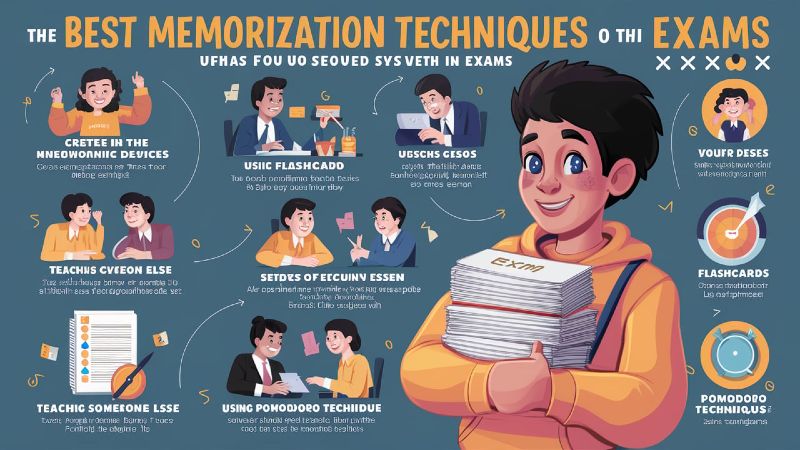Introduction to Potent Memory Aids
Year after year, students are under immense pressure to perform well in the exams. This paper describes effective memorizing methods that could be used to enhance the rate and efficiency of recollection. Both techniques apply the principles of neuroscience to ensure that the learners can easily memorize complex information. Efficient training habits can help readers reach a new level of performance and achieve more confidence in their studies.
The Importance of Strong Memory in Exams
An excellent memory establishes a basis of academic achievement in all subjects. The rate of recall affects the correctness of responses when time is scarce in an exam. Memorization leaves cognitive space available to apply and solve problems. This article demonstrates the process of using memory systems to transform studying time to long-lasting knowledge. The outcome is better performance and less pressure.
Advance your career with must-have skills and explore AI in education. Try live tutoring platforms, manage homeschooling multiple kids, and find affordable homeschool curriculums. Explore more at Study.com.
Literature Review of Best Memorization Methods
In this section, some of the most important strategies that students may use now are presented. The techniques include visual mapping, active recall and spaced repetition, association hooks. Students will learn what style of study suits them. These methods have distinct benefits based on the type and cognitive preferences of subjects. Selecting the optimal combination opens up an individualized memory formula to winning.
Technique 1 Visual Mapping and Mind Maps
Mind maps convert linear notes into animated visual networks of concepts. Students begin with a main idea and they sketch inferior branches identifying sub topics and details. Icons and colors stimulate creativity and enable the brain to code in pictures. This mapping accesses the spatial memory and improves the connections of ideas. It helps people recall information by converting boring written words into appealing pictures.
Technique 2 Chunking and Grouping Information
Chunking involves reducing huge information sources to smaller portions, relatively compact enough to memorize. An example drawn is when a student learns a long sequence of numbers, he/she categories them taking three or four at a time. This reflects the way short term memory functions in groupings. Chunking enhances attention and decreases overloading. It is easier to memorize complex lists and sets of formulae.
Method 3 Spaced Repetition to Remember in the Long-Term
Spaced repetition uses sessions that are spaced increasingly in time. This limits the forgetting curve by strengthening the memory at the weakening point. Applications and flashcards implementing this method maximize the timings of reviews. Students will be able to memorize vocabulary formulas or important facts with ease. The approach enhances memory stamina and establishes storage on solid footing.
Technique 4 Active Recall as a way of fortifying memory access
Active recall makes the brain work to get information out of memory instead of re reading notes. Examples include students quizzing themselves using flashcards and reading out loud questions to which they respond verbally. This technique guarantees comprehension and notes gaps. The more one retrieves, the stronger the neural connections and the more it makes the memory stronger. The mechanism instills confidence and it secures knowledge in simulated examination conditions.
Technique 5 Hooks and Storytelling
Association hooks relate new information to bright imagery prior knowledge or imaginative tales. To memorize a list of things, a student learns to incorporate them into an odd story. Weird pictures enhance remembrance as they capture attention and enhance recollection. This innovative style increases interest and minimizes ennui. It is best used on lists and abstract facts.
Technique 6 Peg System and Memory Palaces H3
It is a classical method of association of numbers or lists with known places or previously memorized pegs. A student gets a fantasy of how he/she walks around the home putting stuff in familiar place. Both locations are associated with recollection of the item. The usage of peg system is good when we have the numbers or the lists with sequences. It enhances the rate of recall as well as makes it possible to remember in high-pressure situations.
Technique 7 Mix Practice and Interleaving
In interleaving, various topics or type of problems are combined during a study session. A student goes through the random course of studying the language of the mathematical history one by one instead of studying one block of math destinations at a time. This change causes memory retrieval and accommodates context change. Interleaving enhances long term retention and flexibility of learners. It emulates the exam responses of changing question types within limited time.
Technique 8 Train Others to Encourage Learning
The repetition of advice to the peer or even to the fictional audience improves the memory. Explanation is a process that demystifies comprehension and reveals knowledge deficiency. This communication challenges students to arrange the ideas logically and recall under the pressure. Learning prompts thorough processing and fixes a memory mark. Reflection based on peers develops memory and communication skills.
Technique 9 Use of Rhymes Acronyms and Mnemonics
Compplicated ideas are simplified into simple patterns with rhymes acronyms and mnemonics. Acronyms are used to memorize processes or steps such as PEMDAS in math. Rhymes develop rhythm that improves audio memory. Mnemonics bring either humor or emotion to facts. Such methods are particularly effective when defining terms and dates. These engage several memory modes simultaneously.
Method 10 Writing and Sketching Annotations
Notes written on paper enhance remembrance over typing. Embellishing sketches or notes, or drawing diagrams or doodles uses visual and kinesthetic memory. It retards thinking in order to encourage more deeper encoding of information. Peny and paper students are able to recall in examination. Handwriting incorporates education into the process in a way that the digital tools might not.

Building a Personalized Memorization Plan
An individualized plan is the one that incorporates techniques with the habits and time limits of the student. The first step is selecting main tools such as spaced repetition and mind maps. Add chunking and active recall, too. Variety should use interleaving of subjects. Wait to teach the practice and other storytelling to difficult things. Repeat and monitor improvements to change the techniques and delivery schedules.
Daily Study Schedule Template
Any session should start with a 5-minute spaced repetition review of the previous sessions. Afterwards employ mind maps and chunking in studying new material by touching 20 minutes of focused study blocks. Add active recalls every 30 minutes in the form of insertion of self quizzes. Speak about the main ideas during 10 minutes. Finish up the session with association hooks to solidify new data prior to sleep.
Weekly, and Monthly Reviewer
Spaced repetition revision is done weekly with an overview of all material learned. Older content more than a month ago is checked in monthly cycles. This creates long term mastery. Review using memory palace review of lists attended previously. Wall the instructions with a mix of teaching and quizzing to check depth of knowledge. Frequencies should be reduced gradually as data goes to long term memory.
Tools and Apps which aid Memory Techniques
There are various apps to promote spaced repetition and active recall. Anki is a flashcard with adjustable interval handling. Quizlet offers flashcards games and decks. Such mind mapping tools as XMind are useful in structuring visual displays in a digital form. Not–Notion and Evernote offer chunking and retrieval note management. Students will benefit when instruments are matched to study style and objectives.
Pros and Cons of Different Techniques
| Technique | Pros | Cons |
|---|---|---|
| Mind Maps | Visual structure boosts retention | Time consuming to draw maps |
| Chunking | Simplifies large info sets into manageable units | May fail for unstructured data |
| Spaced Repetition | Builds durable retention over long term | Requires consistent review commitment |
| Active Recall | Identifies weak spots fast | Demands effort and self discipline |
| Storytelling and Hooks | Adds creativity and fun to learning | May feel silly or time heavy |
| Memory Palaces | Excellent for ordered lists and numbers | Mental effort to build vivid locations |
| Interleaving | Strengthens flexible application | Can feel disjointed in study session |
| Teaching Others | Reinforces understanding | Needs peer or audience environment |
| Mnemonics and Rhymes | Helps with lists definitions and sequences | Less effective for deeper concepts |
| Handwriting Notes | Encourages encoding and focus | Slower than typing and may lack backup |
SEO Best Practices for Studying
Organic rankings are connected with quality learning methods. Google prefers well defined lists and how tos. As a way of depicting the structure of topics, use headings and subheadings such as H2 H3. Add bullet style tables FAQ sections and internal links to related posts. As an example, see the study tips guide at InstituteInfo. Concentrate on user intent and respond to the queries comprehensively.
Scientific Support to Memory Strategies
Spaced repetition active recall and interleaving are high yield learning strategies supported by decades of cognitive research. Neuroimaging indicates that these techniques enhance the synapses in the hippocampus. Research indicates that allowing elaborative encoding and retrieval practice is a game changer on long term recall. Students who had studied those methods in the classroom did much better than their counterparts who had reviewed the information passively.
How To Stay Motivated During The Exam Prep
- Have small quantifiable aims at each sitting.
- Introduce short sort breaks as physical activities or small snacks as rewards of completing.
- Learn with others as means of sharing the responsibility and information.
- Use interleaving to change subject frequently to prevent boredom.
- Think positively of the final exam to increase motivation and concentration.
Preventing Burnout and Keeping a Balance
Make sure to exercise, enough sleep and social to maintain mental energy. Rest days are a good enough opportunity to restoratively study or explore creative hooks tricks. Study sessions of many hours should be avoided and instead the consistent spreading out of practice should be performed. Regular schedules enhance memory retention and prevent stressful efforts on the capacity to retain.
Memorizing Pitfalls
Lots of students overutilize rereading and highlighting. These passive skills do not encourage memory development. Surface learning is also encouraged through last minute cramming. Do not miss review cycles/ feedback loop. Multitasking should be avoided as it separates the attention. Remain rooted in mind tactics that stir brain effort and participation.
Memory Knowledge on Different Learning Styles
The use of mind maps diagrams and color coding is beneficial to visual learners. Auditory learners love to recite the notes aloud and listen to tapes. Kinesthetic learners prefer to sketch the teaching or use gestures when studying. Blending of styles creates stronger ties. Personalize methods to your brain as it takes in and stores information. Performance is enhanced by self awareness.
Nutrition Sleep and Memory Performance
Healthy lifestyle practices are a key to good memory. Sleep helps in consolidation of memory and thinking. Nourishment is the driving force of the brain. Concentrate on foods high in Omega three fatty acids such as fish and walnuts. Drink water to improve attention. Do not eat junk food and sugar spikes that break concentration. There is also the fact that physical movement improves circulation and retention.

Boost your learning with these free online platforms with certificates and learn coding at home step by step. Improve study habits using note-taking strategies and memorization techniques.
Frequently asked questions part
FAQ 1 How long do I need to work on spaced repetition every day?
Take time to revise flashcards or important concepts in about 10 to 15 minutes a day. This is cumulative to permanent retention without losing time. Use progress and challenge of material to determine frequency increases or decreases.
FAQ 2 Can I use mind mapping and spaced repetition together?
Of course you can. Revise your mind maps at spaced repetition sessions. Rew Conduct drawing in mind. This is a combination of both visual and repetition techniques.
FAQ 3 I have trouble memorizing abstract formulae. What can help most?
The formula parts are grouped logically into chunks. Attach association hooks to every part in order to correlate it with a vivid image. Peer instructions also elucidate meaning of every formula part.
FAQ 4 What would you use regarding memory palaces?
Paper drawing suits well with majority of learners. It can be possible to visualise locations through the aid of digital drawing tools. There is less support on apps. It is all about power of imagination and not cool apps.
FAQ 5 How will I monitor what technique is best to me?
Maintain a study log detailing what method you applied, and how good you remembered things. In one week review which percentages were the strongest and which session felt fun. Correct it by concentrating on those strengths.
Conclusion and Future Actions
Using these methods can change studying patterns and test preparation. Create your own hybrid plan using techniques that are appropriate to your style and content. Visit related study strategies at InstituteInfo through internal link to continue learning. Memory mastery motivation happens through regular review and attention. Make a start today with one form of practice and get towards a successful examination at every practice session.

